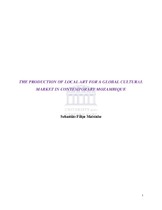| dc.description.abstract | This thesis examines the production of commercial art in contemporary Mozambique. It explores the power relationship between local artists – painters and sculptors – and their patrons and brokers in the art market. This means, on one hand, that it looks at the artworks that have been produced during the late colonial period (1962 – 1974) and the post-colonial periods (June 1975 - 2010) and relates this to the changing political landscape in Mozambique. On the other hand, the aim is to explore the artists’ life histories, especially how their talent was first recognized, their art training (formal or otherwise), previous work experience, and the reasons for their current success (or lack thereof). This is done in order to see how and to what extent their artistic works have been influenced by external forces or actors. The power relationship existing between the art producers and their customers in the art markets in Mozambique is then related to the issue of globalisation. In this process, the study critically analyses who the actual art patrons of Mozambique art are and the extent to which Mozambican art is influenced by global forces. The focus is on a number of artists and the thesis examines their life histories specific to their art production in order to highlight the themes and trends of their art works. It was found that local art produced in Mozambique is not simply responding to local influences but also to global forces, of which the latter dominates. However, the study further reveals that while the art producers are influenced externally by their buyers, they (the art producers) have their own ways of manipulating their buyers in order to be able to sell their products. In other words, the artists have the power of mediating between local, personal influence and that of the patrons. | en_US |

